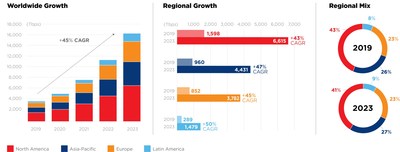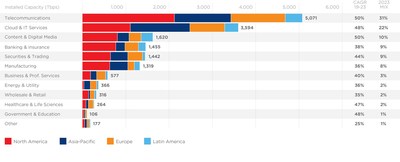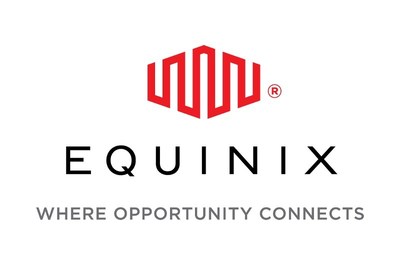Annual Market Study Reveals Pace at Which COVID-19 Is Accelerating Digital Transformation
The Global Interconnection Index (GXI) report from Equinix forecasts significant growth in private connectivity bandwidth driven by the COVID-19 pandemic. By 2023, digital service providers are expected to increase bandwidth fivefold, reaching over 10,000 Tbps. Overall interconnection bandwidth is projected to grow at a 45% CAGR from 2019 to 2023, equating to 64 zettabytes of data exchange. Traditional businesses are shifting towards edge-first architecture, with banking, insurance, and healthcare leading, while Latin America is set for the highest growth rate at 50%. Digital transformation is essential for competitive advantage.
- Interconnection bandwidth is forecasted to grow at a 45% CAGR, reaching over 16,300 Tbps by 2023.
- Predicted demand for interconnection bandwidth from digital service providers is 10,284 Tbps by 2023, nearly double that of enterprises.
- Digital leaders are encouraged to implement digital transformation initiatives now for post-pandemic recovery.
- None.
Insights
Analyzing...
REDWOOD CITY, Calif., Oct. 13, 2020 /PRNewswire/ -- The latest Global Interconnection Index (GXI), an annual market study published by Equinix, shows that the COVID-19 pandemic has already had a dramatic effect on how businesses are planning their digital infrastructure initiatives over the next three years. According to the report, digital service providers, within industries like telecommunications, cloud & IT services, content & digital media and technology providers, are forecast to increase private connectivity bandwidth 5x by 2023, driven by greater demands from enterprises to close digital gaps at the edge.
"As interconnected services, cloud providers, distributed cloud, edge services and SaaS offerings continue to proliferate, the rationale to stay only in a traditional data center topology will have limited advantages. This is not an overnight shift, but an evolutionary change in thinking how we deliver services to our customers and to the business. This trend, coupled with the new reality that outside factors might limit physical access to the data center (such as emergency quarantine), is driving new thinking in infrastructure planning," wrote David Cappuccio, Distinguished VP Analyst, Gartner and Henrique Cecci, Senior Director Analyst, Gartner.1
The report also forecasts that overall interconnection bandwidth, the measure of private connectivity for the transfer of data between organizations, will achieve a
"Digital leaders have to prepare for post-pandemic recovery by planning and implementing the right digital transformation initiatives now," said Claire Macland, Senior Vice President of Marketing, Equinix. "We believe those that have a foundational infrastructure which helps bring together all the right places, partners and possibilities will gain a business advantage over the long term."
The GXI Vol. 4 delivers insights by tracking, measuring and forecasting growth in interconnection bandwidth—the total capacity provisioned to privately and directly exchange traffic, with a diverse set of partners and providers, at distributed IT exchange points inside carrier-neutral colocation data centers.
Vertical/Industry Insights:
The GXI Vol.4 provides insight on how global macro trends and COVID-19 have impacted certain industry segments:
- Digital adoption patterns are changing in response to massive disruptions
- According to the GXI Vol.4, the digital adoption pattern has altered, with service providers now forecast to provision more interconnection bandwidth (10,284 Terabits per second (Tbps) by 2023) than enterprises, by a factor of nearly 2x.
- However, much of this service provider demand is anticipated to be in support of enterprises that are prioritizing their digital transformation in preparation for post-pandemic recovery.
- The report also predicts that enterprises with a digital infrastructure will extend their competitive advantage and continue to lead in business growth, while those without have struggled and are dependent on service providers to transform their business models.
- Traditional businesses are moving workloads to an edge-first architecture
- The GXI Vol.4 predicts that traditional business, within industries like banking & insurance, manufacturing and business & professional services, will represent a combined
30% of global interconnection bandwidth by 2023. This is led by the growing need to move workloads to the digital edge while scaling core IT infrastructure. By 2023, these traditional businesses are expected to reach a peak interconnection bandwidth growth rate of50% annually. - Healthcare & life sciences and government & education are expected to lead the traditional enterprises in their interconnection growth rate as public and private initiatives on artificial intelligence (AI) and machine learning (ML) are forecasted to drive a combined
47% CAGR in interconnection bandwidth from 2019 to 2023. - Organizations are benefiting from the "network effect"
- Organizations are maximizing their digital advantage by building a presence in locations with the most users, largest number of providers and the densest activities, known as the "network effect." According to IDC,
80% of digital leaders will see the impact of connecting to multiple ecosystems, including improving their value to end customers by 2025.2 - The need for application exchange in digital ecosystems to support real-time engagement is essential and creates a network effect for businesses. The GXI Vol.4 predicts that connectivity from service providers to networks and cloud & IT service providers will be the two main sources of ecosystem interconnection, with an estimated
49% combined CAGR from 2019 to 2023.
Regional Insights:
The GXI provides insight into how growth in interconnection bandwidth is expected to accelerate in different regions of the world between 2019 and 2023:
- Global interconnection bandwidth is forecast to grow by
45% CAGR. By 2023, global installed interconnection bandwidth is expected to reach 16,300+ Tbps. - North America is expected to grow at a
43% CAGR, with service providers leading the growth, showing over a 4x increase in interconnection bandwidth. The top metros for private connectivity growth in the region are forecasted to be Silicon Valley, Washington D.C., Chicago and New York. - Europe is forecast to grow at a
45% CAGR, where telecommunications and cloud & IT providers are to contribute to55% of the total interconnection bandwidth growth, outpacing other industries in the region. Frankfurt, Amsterdam, Paris and London are predicted to be the top metros for interconnection bandwidth growth. - Asia-Pacific is expected to grow at a
47% CAGR. Cloud & IT Services are to lead the growth in this region, reaching an anticipated 1,374 Tbps by 2023, which is29% more than the next largest region, North America, in this sector. The GXI Vol.4 anticipates healthcare & life sciences and government & education to see an acceleration in interconnection bandwidth adoption as both industries prioritize digital initiatives such as telehealth and AI. The leading metros for private connectivity within the region are expected to be Singapore, Sydney, Tokyo, Shanghai and Hong Kong. - Latin America is predicted to grow at a
50% CAGR. Content and digital media is expected to grow at a 5-year CAGR of62% between 2019 and 2023, making it the highest growth rate of any sector in any region. Buenos Aires, Mexico City, Rio de Janeiro and Sao Paulo are expected to be the top metros in this region for interconnection bandwidth growth.
Industry Perspective on the Global Interconnection Index
- Debika Bhattacharya, VP-Global Solutions, Verizon Business
"With the pandemic creating a sudden global shift to remote and work-from-home practices, our customers have a renewed appreciation of the need for reliable networking solutions. Prioritizing digital transformations and cloud connectivity is imperative. Our top priority is to provide customers with differentiated solutions to drive business agility so they can achieve their goals and mitigate risks."
Additional Resources
- Global Interconnection Index Volume 4 [report]
- GXI V4 Blog [blog]
- Your Data Center May Not Be Dead, but It's Morphing [Gartner report]
- Total Economic Impact Study (TEI) [Forrester report]
- Future of Digital Infrastructure—Ever Faster Delivery of Reliable Digital Services and Experiences [IDC report]
About the Global Interconnection Index (GXI)
The Global Interconnection Index, published annually by Equinix, delivers insights that drive digital business advantage by tracking, measuring and forecasting growth in interconnection bandwidth—the total capacity provisioned to privately and directly exchange traffic with a diverse set of counterparties and providers at distributed IT exchange points. The Global Interconnection Index is the industry's only market study that projects how interconnection bandwidth growth will unfold through 2023. The report serves as a market baseline that analyzes the deployment profile of thousands of ecosystem participants using carrier-neutral colocation data center providers globally. This data was combined with local and regional market data (including macroeconomic trends, market demographics and industry concentrations) to form a weighted demand multiplier to assist in predicting growth and assess impact on digital business transformation. A detailed methodology description is included in the Global Interconnection Index.
About Equinix
Equinix (Nasdaq: EQIX) is the world's digital infrastructure company, enabling digital leaders to harness a trusted platform to bring together and interconnect the foundational infrastructure that powers their success. Equinix enables today's businesses to access all the right places, partners and possibilities they need to accelerate advantage. With Equinix, they can scale with agility, speed the launch of digital services, deliver world-class experiences and multiply their value.
Forward Looking Statements
This press release contains forward-looking statements that involve risks and uncertainties, including statements about interconnection bandwidth growth, the rate of adoption of digital transformation, and the benefits of the "network effect". Actual results may differ materially from expectations discussed in such forward-looking statements and the predictions made from the Global Interconnection Index. Factors that might cause such differences include risks described from time to time in Equinix filings with the Securities and Exchange Commission. In particular, see recent Equinix quarterly and annual reports filed with the Securities and Exchange Commission, copies of which are available upon request from Equinix. Equinix does not assume any obligation to update the forward-looking information contained in this press release.
1 "Your Data Center May Not Be Dead, but It's Morphing," Gartner, September 17, 2020
2 "IDC FutureScape Webcast: Worldwide Digital Transformation 2020 Predictions," IDC, Doc # US46287720, May 2020
![]() View original content to download multimedia:http://www.prnewswire.com/news-releases/annual-market-study-reveals-pace-at-which-covid-19-is-accelerating-digital-transformation-301150737.html
View original content to download multimedia:http://www.prnewswire.com/news-releases/annual-market-study-reveals-pace-at-which-covid-19-is-accelerating-digital-transformation-301150737.html
SOURCE Equinix, Inc.










